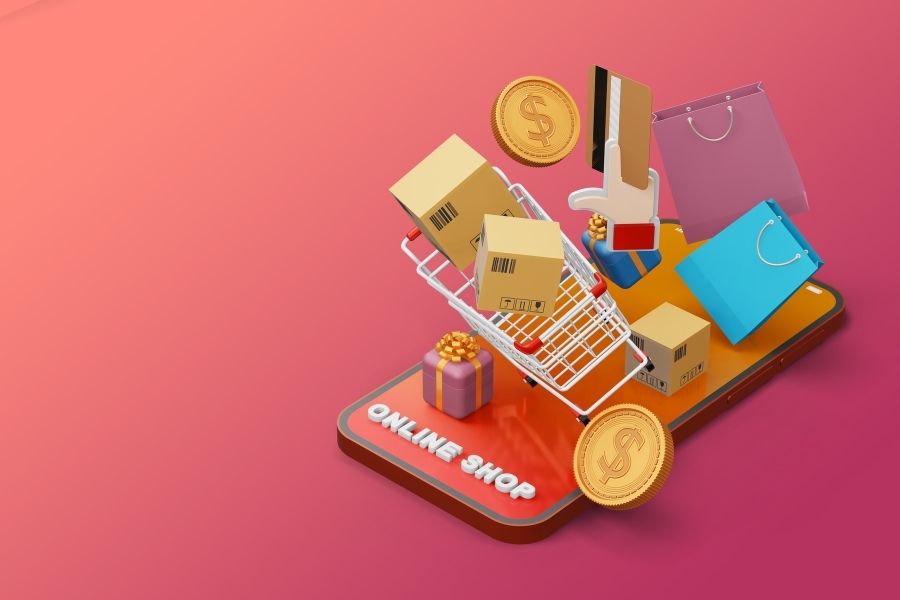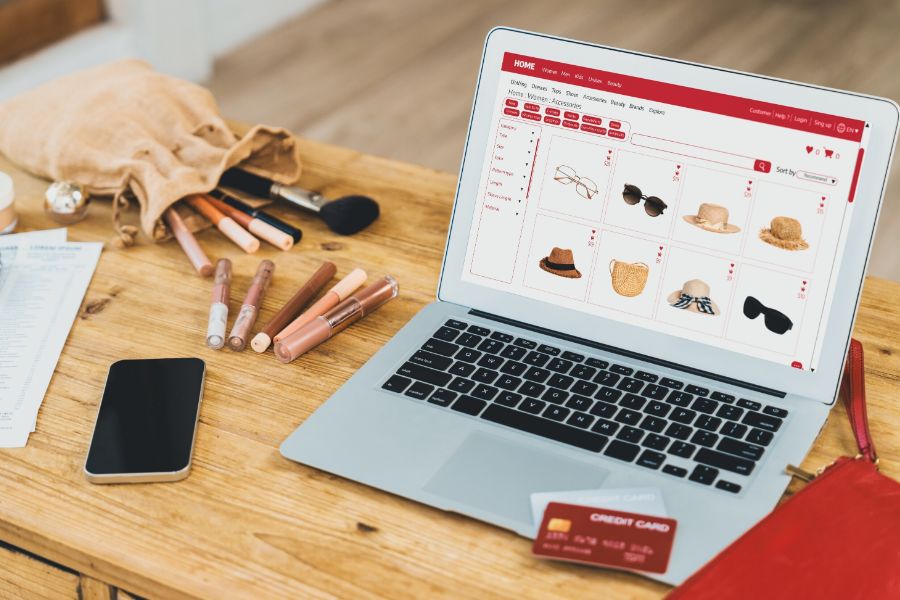Transitioning from a traditional brick-and-mortar store to online retail can be a game-changer, allowing businesses to reach a wider audience, increase sales, and thrive in the competitive eCommerce basic market.
This article serves as a comprehensive guide to help businesses navigate the process of transitioning from a brick-and-mortar store to an online retail presence. We will explore the fundamental aspects of this transformation, from setting up an online store and choosing the right retail solution provider.
Why Should You Open An Online Shop?
Having an online shop can be an excellent return on your effort, and there are several compelling reasons why you should consider it.
Giving you the chance to reach a larger audience
Unlike traditional brick-and-mortar stores, an online store isn’t confined by geographical boundaries or restricted to specific operating hours. Instead, it serves as a virtual shop front that operates round the clock, accessible to anyone with an internet connection, even while you’re asleep.
The internet is brimming with tales of triumph for businesses that have seamlessly integrated eCommerce basic into their existing brick-and-mortar setups, allowing them to scale their operations efficiently and effectively. By harnessing the power of an online store, these success stories serve as a testament to the endless possibilities and potential for growth that can be achieved in the digital realm.
Building business resilience is another key benefit
In uncertain times, establishing an online presence for your business builds resilience. Online retail is here to stay, offering protection against rising costs, weather-related limitations, and global events.
It also retains customers by providing an additional buying channel for those who move or have busy schedules. By going digital, you ensure business continuity and cost-effective customer retention. Embrace the online realm for a resilient future.
Flexible working hours
Enjoy the freedom of flexible hours when you operate an online store. Unlike brick-and-mortar retail, you won’t be tied to a physical counter or the management of staff. This time efficiency allows you to focus on more rewarding and profitable aspects of your business.
Use the extra time to innovate and create new products, enhance your marketing strategies, or simply savor a well-deserved work-life balance. With online selling, you gain the flexibility to prioritize what truly matters to you.
Essential Aspects When Transitioning from Brick-and-mortar Store to Online Retail
Setting Up an eCommerce Store
As eCommerce platforms become increasingly user-friendly, setting up and designing an online store no longer needs to be daunting for brick-and-mortar retailers. To navigate this process effectively, it’s important to adopt a mindset of MVP (Minimum Viable Product) versus long-term aspirations.
By selecting a visually appealing theme that aligns with your store’s aesthetic and functional requirements, you can swiftly bring your store to the MVP stage. Leveraging the work done by professional designers, you can publish and promote your site without waiting for perfection, as perfection can be an ever-moving goalpost.
Shipping and Fulfillment
If you haven’t had an eCommerce basic presence until now, shipping and fulfillment will be one of the biggest changes you’ll face. It introduces a whole new logistical layer that requires careful planning and upfront consideration.
The first step is deciding how you will handle packing and shipping: whether you’ll do it in-house or outsource to a fulfillment service. Doing it in-house can result in higher profit margins, but outsourcing is often more efficient and scalable. Consider your short-term and long-term goals when making this decision.
Regardless of your choice, it’s important to ensure that your eCommerce basic platform integrates smoothly with your preferred shipping provider(s). This integration will streamline the shipping process and ensure a seamless experience for your customers.
A Point-of-sale Solution
Transitioning from a brick-and-mortar store to online retail requires a dedicated point-of-sale (POS) solution. Here’s why it’s essential:
- Streamlined Operations: A dedicated POS solution simplifies managing your online store, from inventory tracking to order processing and sales monitoring.
- Integrated Inventory Management: It enables seamless inventory management across online and physical channels, preventing stockouts and improving order fulfillment.
- Omni-channel Consistency: Maintain a consistent shopping experience by syncing product information, pricing, and promotions across all sales channels.
- Secure Payment Processing: A dedicated POS solution integrates with trusted payment gateways, ensuring secure checkout and reducing the risk of fraud.
- Advanced Reporting: Gain valuable insights into sales trends, customer behavior, and product performance for data-driven decision-making and business optimization.
Tips to Set Up a POS System
Choose the right retail solution provider
Before delving into the specific steps and technical aspects, it is important to ensure that you have chosen a reliable and suitable POS/retail management system. Take the time to research and compare different options to find the solution that aligns with your business requirements. Having the right retail software and hardware in place will greatly facilitate the setup process.
While we won’t go into extensive detail about the process of purchasing a POS system here, we recommend considering these factors and steps:
- Define your business needs
- Select the most appropriate hardware
- Establish a budget for your POS system
- Conduct side-by-side evaluations of different solutions
Deciding on the desired store configuration
The setup process for your POS system will vary based on the specific setup and operations of your store. To determine the appropriate steps to take, consider the following questions:
- What devices will be necessary for processing sales? (e.g., computers, tablets, etc.)
- How many registers will be required?
- What forms of payment will you accept?
By answering these questions, you will be better equipped to gather the necessary materials and equipment, simplifying the setup process for both you and the individuals responsible for implementing your POS system.
Who will set up your POS?
The DIY (Do-it-yourself) option
For those with a straightforward store setup (such as using only an iPad), setting up your POS system independently is often achievable. The process usually involves launching or installing the POS software, which can be done with just a few clicks, and entering your business details.
To ensure a smooth setup, you can refer to video tutorials, help articles, and documentation provided by your POS provider. If they offer free technical support, it’s beneficial to engage with their team through a call and seek their guidance on the best approach to configure your point of sale system.
The self-setup option is particularly suitable for single-store retailers with uncomplicated workflows and shorter processes.
Get help from your POS vendor
For retailers with more complex retail operations or those managing multiple stores with extensive product catalogs, it is advisable to seek support from your POS vendor. Most solution providers offer onboarding services specifically designed to help retailers get up and running efficiently.
These valuable services often include:
- Team training
- Product upload assistance
- Store data migration
- Settings configuration
- Integration with other applications
Many of these tasks can be performed remotely, with your POS provider serving as a highly engaged partner who guides you through the entire process. Their expertise and support ensure a smoother transition to your new POS system.
To sum up,
Transitioning from a brick-and-mortar store to online retail requires careful planning and execution. By following the essential aspects and tips discussed in this article, you can successfully set up your online store and integrate a reliable POS system.
To streamline your operations and provide a seamless shopping experience, consider implementing ConnectPOS. Our feature-rich solution offers efficient transaction processing, inventory management, and valuable analytics.
Don’t miss out on the opportunities of online retail. Contact ConnectPOS and take your retail business to new heights in the world of eCommerce basic.
ConnectPOS is a all-in-one point of sale solution tailored to meet your eCommerce POS needs, streamline business operations, boost sales, and enhance customer experience in diverse industries. We offer custom POS with features, pricing, and plans to suit your unique business requirements.




